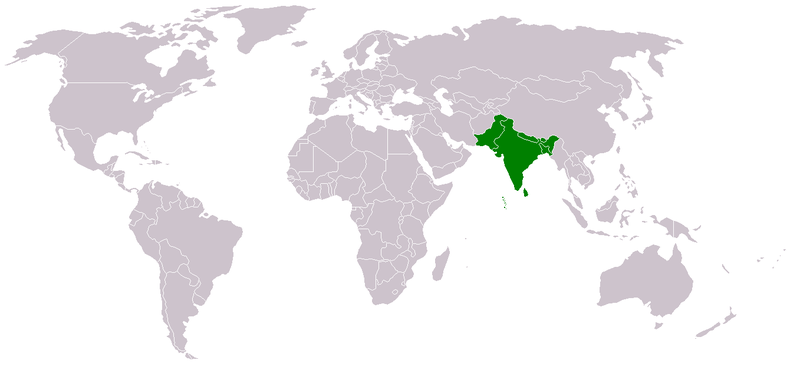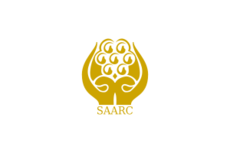South Asian Association for Regional Cooperation
 |  |
Name: South Asian Association for Regional Cooperation | |
| Acronym: SAARC | |
| Year of foundation: 1985 | |
| Headquarters: Kathmandu, Nepal | |
| Official web site: go to page | |
| SAARC documents: go to page |
History
The idea of regional cooperation in South Asia was first mooted in May 1980. The Foreign Secretaries of the seven countries met for the first time in Colombo in April 1981. The Committee of the Whole, which met in Colombo in August 1981, identified five broad areas for regional cooperation. New areas of cooperation were added in the following years.
The South Asian Association for Regional Cooperation (SAARC) was established when its Charter was formally approved on 8 December 1985 by the Heads of State or Government of Bangladesh, Bhutan, India, Maldives, Nepal, Pakistan and Sri Lanka. Afghanistan became a member of SAARC during the Fourteenth SAARC Summit held in Delhi, India in April 2007. Until 2009 China, Japan, Republic of Korea, USA, Iran, Mauritius, Australia, Myanmar and the European Union have joined SAARC as Observers.
SAARC provides a platform for the peoples of South Asia to work together in a spirit of friendship, trust and understanding. It aims to promote the welfare of the peoples of South Asia and to improve their quality of life through accelerated economic growth, social progress and cultural development in the region. During the Fifteenth Summit, the Heads of State or Government emphasized the importance of maintaining the momentum through clear links of continuity between the work already underway and future activities and recognized the need for SAARC to further strengthen its focus on developing and implementing regional and sub-regional projects in the agreed areas on a priority basis. They also renewed their resolve for collective regional efforts to accelerate economic growth, social progress and cultural development and emphasized on key issues like telecommunication, energy, climate change, transport, poverty alleviation, science and technology, trade, education, food security and tourism.
Cooperation in SAARC is based on respect for the five principles of sovereign equality, territorial integrity, political independence, non-interference in internal affairs of the member states and mutual benefit.
Regional cooperation is seen as a complement to the bilateral and multilateral relations of SAARC Member States.
The SAARC Secretariat
The SAARC Secretariat is based in Katmandu. It coordinates and monitors implementation of activities,prepares for and services meetings, and serves as a channel of communication between the Association and its Member States as well as other regional organizations.
The Secretariat is headed by the Secretary General, who is appointed from Member States in alphabetical order for a three-year term by the SAARC Council of Ministers.
H.E. Dr. Sheel Kant Sharma of India is the current Secretary General of SAARC.
The Secretary General is assisted by eight Directors on deputation from Member States.
The SAARC Secretariat and Member States observe 8 December as the SAARC Charter Day.
Structure and Decision making process
Decisions are taken on the basis of unanimity. Bilateral and contentious issues are excluded from the deliberations of SAARC. Preparatory meetings were held prior to the First Summit in Dhaka. The Foreign Secretaries in 1981 in Colombo and the Foreign Ministers in 1983 in New Delhi identified areas to promote regional cooperation. The areas of cooperation under the reconstituted Regional Integrated Program of Action, which is pursued through the Technical Committees, now cover Agriculture and Rural Development; Health and Population Activities; Women, Youth and Children; Environment and Forestry; Science and Technology; Transport; and Human Resource Development.
Working Groups have also been established in the areas of Information and Communications Technology (ICT); Biotechnology; Tourism; and Energy.
The Summits
Summits, which are the highest authority in SAARC, are to be held annually. The country hosting the Summit holds the Chair of the Association. Sri Lanka, which hosted the Fifteenth Summit in Colombo in August 2008, is the current Chair of the Association. To date Fifteen Summits have been held. The Sixteenth Summit will be hosted by Bhutan in April 2010.
The Council of Ministers
The Council of Ministers comprising Foreign Ministers, meets at least twice a year. Its functions include formulating policy, reviewing progress of regional cooperation, identifying new areas of cooperation and establishing additional mechanisms that may be necessary.
The Standing Committee
The Standing Committee comprising Foreign Secretaries, monitors and coordinates SAARC programs of cooperation, approves projects including their financing and mobilizes regional and external resources. It meets as often as necessary and reports to the Council of Ministers. To date, the Committee has held Thirtysix regular and Five Special Sessions. The Association also convenes various Ministerial level meetings to focus attention on specific areas of common interest.
These have now become an integral part of the SAARC process.
The Committee on Economic Cooperation (CEC) comprising Commerce / Trade Secretaries of Member States oversees cooperation in the economic field. So far, it has held fourteen meetings. The Agreement on SAARC Preferential Trading Arrangement (SAPTA) was signed on 11 April 1993 during Seventh SAARC Summit held in Dhaka, Bangladesh and entered into force on 7 December 1995.
Subsequently, with the objective of moving towards a South Asian Economic Union (SAEU), the Agreement on South Asian Free Trade Area (SAFTA) was signed on 6 January 2004 during the Twelfth SAARC Summit held in Islamabad, Pakistan and entered into force on 1 January 2006. The SAFTA Ministerial Council (SMC) is the highest decision-making body of SAFTA and is responsible for the administration and implementation of Agreement and alldecisions and arrangements made within its legal framework.
SAARC Development Fund (SDF) has come into operation with three Windows (Social, Economic and infrastructure) and an initial paid up capital of US$ 300 million. With its Permanent Secretariat to be established in Thimphu two Regional Projects under Social Window are already under implementation.
